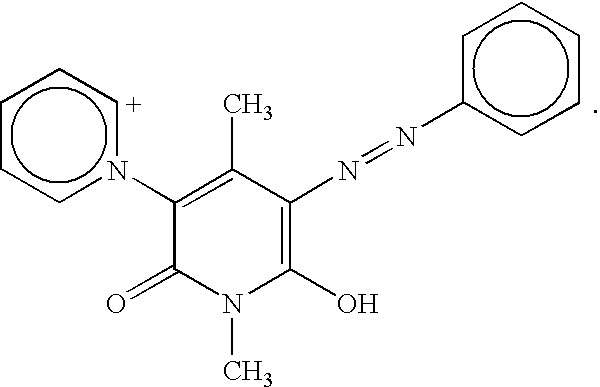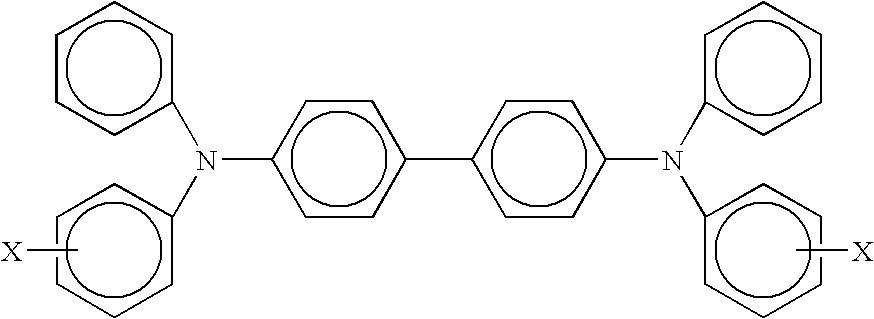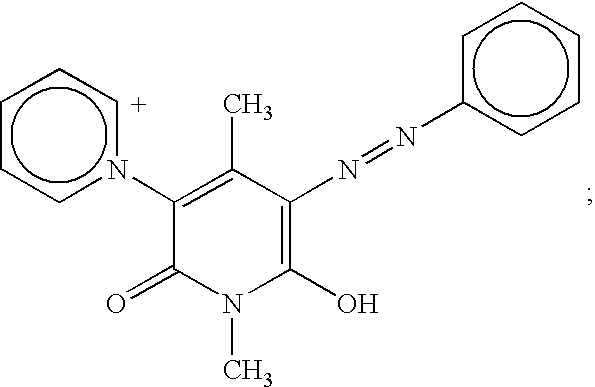Photoconductive members
a technology of photoconductive and imaging members, applied in the field of imaging members, can solve the problems of non-uni formation of non-uniform and unacceptable, non-uniformity in the electrical properties of the imaging member, etc., and achieve excellent photosensitivity, prevent interaction, and excellent photosensitivity
- Summary
- Abstract
- Description
- Claims
- Application Information
AI Technical Summary
Benefits of technology
Problems solved by technology
Method used
Image
Examples
example ii
[0044]A hydroxygallium phthalocyanine (HOGaPc (V)) charge generator layer was prepared by repeating the processes of Example I. A transport layer solution was then generated by mixing 10 grams of N,N′-diphenyl-N,N′-bis(3-methylphenyl)-1,1-biphenyl-4,4′-diamine (TPD), 10 grams of polycarbonate resin (available as MAKROLON 5705® from Bayer A.G.), and 133 grams of methylene chloride. The solution was stirred overnight (about 18 to about 20 hours throughout) until a complete solution was obtained. The resulting transport solution was coated onto the above photogenerating layer using a Bird film applicator with a 4 mil gap.
[0045]The above transport layer was then overcoated with a mixture of 0.7 gram of a polyamide containing methoxymethyl groups (LUCKAMIDE® 5003 available from Dai Nippon Ink), 0.3 gram of ELVAMIDE® 8063 (available from E.I. DuPont), methanol (3.5 grams) and 1-propanol (3.5 grams) from a 2 ounce amber bottle and warmed with magnetic stirring in a water bath at about 60° ...
example iii
[0048]A hydroxygallium phthalocyanine (HOGaPc (V)) charge generator layer was prepared following the processes as described in Example I. A transport layer solution was then generated by mixing 10 grams of N,N′-diphenyl-N,N′-bis(3-methylphenyl)-1,1-biphenyl-4,4′-diamine (TPD), 10 grams of polycarbonate resin (available as MAKROLON® 5705 from Bayer A.G.), and 133 grams of methylene chloride. The resulting mixture was stirred overnight until a complete solution was obtained. The transport solution was coated onto the above photogenerating layer using a Bird film applicator with a 4 mil gap. The resulting member was dried at 100° C. in a forced air oven for 30 minutes.
[0049]The above transport layer was then overcoated with a mixture of 0.7 gram of a polyamide containing methoxymethyl groups (LUCKAMIDE® 5003 available from Dai Nippon Ink), 0.3 gram of ELVAMIDE® 8063 (available from E.I. DuPont), methanol (3.5 grams) and 1-propanol (3.5 grams) from a 2 ounce amber bottle and warmed with...
example iv
[0052]A hydroxygallium phthalocyanine (HOGaPc (V)) charge generator layer was prepared by following the processes as described in Example I. A hole transport layer solution was then generated by mixing 10 grams of N,N′-diphenyl-N,N′-bis(3-methylphenyl)-1,1-biphenyl-4,4′-diamine (TPD), 10 grams of polycarbonate resin (available as MAKROLON® 5705 from Bayer A.G.), and 133 grams of methylene chloride. The mixture resulting was stirred overnight until a complete solution was affected. The transport solution was coated onto the above photogenerating layer using a Bird film applicator with a 4 mil gap. The resulting member was dried at 100° C. in a forced air oven for 30 minutes.
[0053]The above transport layer was then overcoated with a mixture of 0.7 gram of a polyamide containing methoxymethyl groups (LUCKAMIDE® 5003 available from Dai Nippon Ink), 0.3 gram of ELVAMIDE® 8063 (available from E.I. DuPont), methanol (3.5 grams) and 1-propanol (3.5 grams) from a 2 ounce amber bottle and war...
PUM
 Login to View More
Login to View More Abstract
Description
Claims
Application Information
 Login to View More
Login to View More - R&D
- Intellectual Property
- Life Sciences
- Materials
- Tech Scout
- Unparalleled Data Quality
- Higher Quality Content
- 60% Fewer Hallucinations
Browse by: Latest US Patents, China's latest patents, Technical Efficacy Thesaurus, Application Domain, Technology Topic, Popular Technical Reports.
© 2025 PatSnap. All rights reserved.Legal|Privacy policy|Modern Slavery Act Transparency Statement|Sitemap|About US| Contact US: help@patsnap.com



